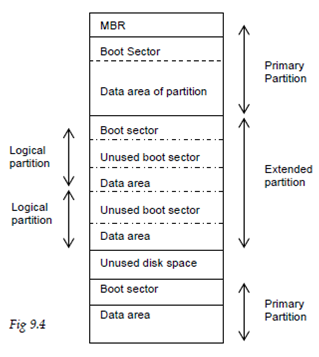Extended and Logical Partitions
Originally, the partitioning scheme for PC hard disks permitted only four partitions that turned out to be insufficient whenever more than four OS (MS-DOS, Linux, OS/2, Minix, NetBSD, Windows or Windows NT, or FreeBSD, to name a few) were needed. Sometimes it is wise to have various partitions for one operating system. For instance, in Linux, placing the swapspace in it's own partition raise its speed than placing it in the major partition.
To overcome this design problem and extended partitions were invented. This permits partitioning a main partition into sub-partitions. The primary partition therefore subdivided is the extended partition; the sub partitions are logical partitions. They behave such as primary partitions, but are created another way. There is no difference in speed among them.
The partition structure of a hard disk appears as in the given figure below. The disk is separated into three primary partitions, the second of that is separated into two logical partitions. But category of the disk is not partitioned. The disk as an overall and every primary partition has a boot sector.
